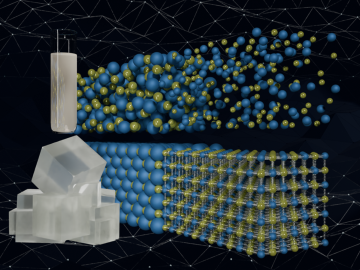
Filter News
Area of Research
- Advanced Manufacturing (6)
- Biological Systems (1)
- Biology and Environment (13)
- Computational Biology (1)
- Computer Science (2)
- Electricity and Smart Grid (1)
- Energy Science (36)
- Fusion Energy (1)
- Isotopes (3)
- Materials (25)
- Materials for Computing (8)
- National Security (4)
- Neutron Science (6)
- Nuclear Science and Technology (1)
- Quantum information Science (1)
- Sensors and Controls (1)
- Supercomputing (7)
News Type
News Topics
- (-) Bioenergy (17)
- (-) Composites (11)
- (-) Cybersecurity (3)
- (-) Frontier (1)
- (-) Grid (22)
- (-) Isotopes (5)
- (-) Materials (36)
- (-) Microscopy (11)
- (-) Nanotechnology (12)
- (-) Summit (8)
- 3-D Printing/Advanced Manufacturing (34)
- Advanced Reactors (13)
- Artificial Intelligence (16)
- Big Data (17)
- Biology (21)
- Biomedical (11)
- Biotechnology (4)
- Buildings (21)
- Chemical Sciences (13)
- Clean Water (14)
- Computer Science (42)
- Coronavirus (11)
- Critical Materials (12)
- Emergency (1)
- Energy Storage (32)
- Environment (48)
- Exascale Computing (1)
- Fossil Energy (1)
- Fusion (9)
- High-Performance Computing (12)
- Hydropower (6)
- Irradiation (2)
- ITER (3)
- Machine Learning (14)
- Materials Science (34)
- Mathematics (3)
- Mercury (3)
- Molten Salt (5)
- National Security (3)
- Neutron Science (27)
- Nuclear Energy (19)
- Partnerships (2)
- Physics (4)
- Polymers (10)
- Quantum Computing (5)
- Quantum Science (12)
- Security (1)
- Simulation (9)
- Space Exploration (10)
- Statistics (1)
- Transportation (36)
Media Contacts

Scientists have developed a new machine learning approach that accurately predicted critical and difficult-to-compute properties of molten salts, materials with diverse nuclear energy applications.

Scientists at ORNL have developed a vacuum-assisted extrusion method that reduces internal porosity by up to 75% in large-scale 3D-printed polymer parts. This new technique addresses the critical issue of porosity in large-scale prints but also paves the way for stronger composites.

Scientists at Oak Ridge National Laboratory and the University of Colorado Boulder used a gene-silencing tool and a large library of molecular guides to understand how photosynthetic bacteria adapt to light and temperature changes. They found that even partial suppression of certain genes yielded big benefits in modifying the stress response of wild microbes.

Researchers at Oak Ridge National Laboratory have developed a new automated testing capability for semiconductor devices, which is newly available to researchers and industry partners in the Grid Research Integration and Deployment Center.

Researchers at Stanford University, the European Center for Medium-Range Weather Forecasts, or ECMWF, and ORNL used the lab’s Summit supercomputer to better understand atmospheric gravity waves, which influence significant weather patterns that are difficult to forecast.

Oak Ridge National Laboratory researchers are using a new bioderived material to 3D print custom roosting structures for endangered bats.

Researchers have developed and 3D printed the lightest crack-free alloy capable of operating without melting at temperatures above 2,400 degrees Fahrenheit, which could enable additively manufactured turbine blades to better handle extreme temperatures, reducing the carbon footprint of gas turbine engines such as those used in airplanes.

Researchers at Oak Ridge National Laboratory have opened a new virtual library where visitors can check out waveforms instead of books. So far, more than 350 users worldwide have utilized the library, which provides vital understanding of an increasingly complex grid.

Oak Ridge National Laboratory scientists have developed a method leveraging artificial intelligence to accelerate the identification of environmentally friendly solvents for industrial carbon capture, biomass processing, rechargeable batteries and other applications.

ORNL researchers used electron-beam additive manufacturing to 3D-print the first complex, defect-free tungsten parts with complex geometries.


